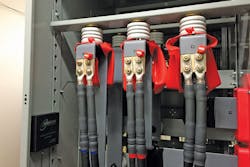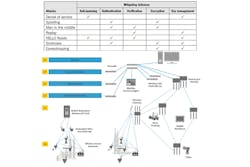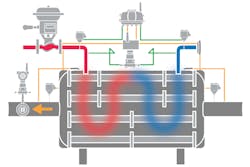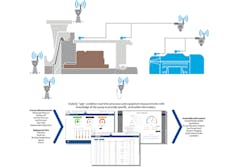Industrial Internet of Things in energy management
The Internet of Things (IoT) leverages low-cost, low-power microprocessors and radios with the internet to improve the usability, safety and energy efficiency of vehicles and common objects found in homes, stores and offices. The Industrial Internet of Things (IIoT) can provide the same benefits while meeting industrial expectations of security, reliability and conformance to standards. This article reviews how industrial users apply IIoT concepts to improve plant energy efficiency.
IIoT versus IoT
The IoT is applied in consumer markets to a wide variety of uses.
In most cases, an IoT application works by taking a common device, such as a tire or a speaker, and making it "smart" by integrating several technologies, most of which have only become practical over the past few years:
• Low-cost, low-power and battery-equipped sensors, e.g., tire-pressure sensors in a vehicle or motion and ambient-temperature sensors in a home
• Wireless and wired communication networks with data interpretation by local or internet cloud-based intelligence
• Intelligent displays (digital dashboards) to communicate actionable information to a non-specialist human operator via a smartphone app or tablet, or mounted on a vehicle dashboard
IIoT applications start with common industrial devices such as steam traps, pressure relief valves and heat exchangers. The applications take data from industrial sensors and add networking mechanisms and dashboards. The key difference between consumer and industrial capabilities in this context is the need for open standards and much higher expectations of reliability and security.
WirelessHART
Consumer IoT applications leverage standards-based network technologies, such as Wi-Fi and Bluetooth, but superimpose proprietary implementations. This typically means that a smart door lock purchased from one supplier cannot be integrated with a smart motion sensor purchased from another. Individual suppliers change technologies as smaller companies are acquired or discontinue products, which means investments made with earlier-generation products are sometimes wasted. Industrial users cannot tolerate such changes and therefore demand stable open standards, with devices and support available from multiple suppliers. This ensures that any investment made — in hardware, tools or training — can be leveraged across many applications and will not turn into a dead end if any given supplier discontinues an application or technology.
Industrial users are familiar with the HART open protocol, which is used with more than 80 percent of smart wired transmitters today. While new or existing HART wired sensors can be integrated into an IIoT application, most new installations use the wireless version of HART — referred to as WirelessHART, HART 7 or IEC-62591. Key benefits of wireless include reduced cost and space, simpler and faster installation and no need for a process shutdown in many cases.
WirelessHART uses a mesh network, so every device can communicate to the host through many other devices, eliminating single points of failure. While no communication method can be 100 percent reliable, experience from thousands of installations demonstrates that a properly designed mesh network can provide reliability equal to wired devices since it eliminates many of the common failure points of a wired network such as loose connections, damaged wires and bad power supplies.
Figure 1. WirelessHART includes robust, multi-tiered, always-on security using a variety of defensive mechanisms for the most critical applications.
Many consumer IoT products were designed without strong security protections and have proved easy to hack or spoof. A WirelessHART installation includes multiple levels of protection against interference and attack:
- WirelessHART is not routable, or in other words, no "IP to the edge"
- Secure device-provisioning using a wired connection used to insert a secret join key
- Robust device-joining process, including device access control list when unique join keys are employed for whitelisting
- AES-128 encryption of individual end-to-end sessions within the sensor web
- Secure browser front-end supports role-based access control
No communication, wired or wireless, can be 100-percent secure, but a properly designed WirelessHART application (see Figure 1) can provide security equal to wired networks. WirelessHART is used in the most critical applications, including those that require NERC CIP compliance.
IIoT applications: Steam traps and pressure relief valves
Steam traps serve two purposes. First, they ensure the steam used for process or space heating is free of condensate and noncondensable fluids. Second, they ensure that no live steam is returned to the condensate system. Steam traps are mechanical components, so they have no means to detect and signal a failure electronically. Consequently, most users inspect them at least annually to assess their operation and look for failures.
Some failure modes lead to ongoing wasted energy, reduced production or worse. In an application in which steam is used for freeze protection, a leaky steam trap can impede steam flow and result in a piping system freeze, causing downtime and safety risks. More seriously, a cold trap allows condensate to accumulate in the steam piping, which can result in water hammer, the unexpected release and associated shock wave of high-pressure steam and condensate, which can cause extensive property damage, sever injury or death.
While steam traps cannot monitor themselves, it is possible to add an acoustic device upstream of the steam trap to listen for sounds characteristic of a properly or improperly functioning steam trap. Identifying those requiring attention can help a maintenance department fix problems quickly, thereby reducing ongoing energy cost, improving process throughput and reducing the risk of freezing. Identifying a cold trap could even prevent a catastrophic piping system failure.
A pressure relief valve (PRV) is set to open when the process pressure approaches a predetermined level below the safe limits of the process equipment or piping, with the excess pressure typically vented to atmosphere or a flare. Excess flaring causes process loss, safety risk and environmental impact. A PRV should close itself after the pressure returns to a safe condition, but it is common for dirt in the process fluid to prevent it from fully reseating and allowing it to continue leaking, a difficult condition to detect. Similar to the steam trap application, an acoustic sensor clamped onto the pipe downstream of the PRV will immediately identify a full release as well as any ongoing leaks from incomplete valve seating.
“Ideally, steam trap and PRV suppliers would provide not just monitoring devices, but analytic software capable of interpreting signals from existing wired and new wireless devices.”
Ideally, steam trap and PRV suppliers would provide not just monitoring devices, but analytic software capable of interpreting signals from existing wired and new wireless devices. Plant operators do not need to be advised of — and distracted by — alerts for individual steam traps. Instead, the system would advise only the department responsible for steam trap maintenance when action needs to be taken to ensure plant safety and reliability. This can be done using an effective dashboard to simplify the data presentation.
Figure 2. When commissioned, heat exchangers typically have minimal instrumentation. Adding instruments supported with analytical tools can help optimize control and maintenance strategy, improving efficiency and reliability.
IIoT applications: Heat exchangers and pumps
When a typical heat exchanger is installed and commissioned, it has minimal instrumentation. Often it does little more than monitor the outlet temperature, which is used to operate a heating or cooling valve in a feedback loop. Any disturbance in inlet temperature or flow rate eventually causes a change in outlet temperature, causing the controller to move the valve until the temperature returns to setpoint. While this strategy maintains the right average outlet temperature more or less, positioning the temperature sensor at the outlet means much can change within the exchanger before it is realized. Constant variation can impact product quality and lead to premature wear of the heat exchanger.
A better approach is to maintain heat balance by measuring all heat inputs and using feedforward control of the valve to counteract any change in inlet temperature or flow before it affects the outlet temperature. This improves temperature stability for better product quality and reduced wear. The same heat balance data can be used to calculate heat exchanger efficiency.
Additionally, the analytic software can combine knowledge of the heat exchanger properties to evaluate equipment health and guide predictive maintenance. It can draw on history and industry standards to compare how this unit compares to best-in-class performance, what improvement is likely if the exchanger is cleaned at the next opportunity and what degradation is likely if it is not.
Take a moment to see how an installation can be upgraded. In Figure 2, outlet temperature and process flow measurements exist. These are combined with new measurements, including:
- Temperature at the process inlet
- Inlet and outlet temperatures of the heating/cooling fluid
- Pressure drop across heat exchanger
New technologies can minimize cost and downtime when implemented as illustrated:
- A single wireless transmitter can collect data from up to four temperature sensors and send all measurements in turn using a common transmitter and radio.
- Instead of traditional welded-in thermowells, externally mounted, clamp-on temperature sensors can infer process temperature from the surface reading, compensating for heat transfer and ambient temperature. This minimizes cost, eliminates downtime and avoids potential leak paths.
- A wireless differential pressure transmitter can monitor pressure drop across the exchanger, providing local and remote visibility.
- A flowmeter equipped with a conditioning orifice provides accuracy without multiple lengths of straight pipe.
“New multivariable transmitters measure pump operating characteristics (vibration, temperature, power and speed) and compare existing conditions to equipment limits.”
A similar opportunity exists for pumps. New multivariable transmitters measure pump operating characteristics (vibration, temperature, power and speed) and compare existing conditions to equipment limits. Process pressure measurements can be combined with guided-wave radar level transmitters and leak detection sensors ensure integrity of the sealing and lubrication system. The analytics app (see Figure 3) is preconfigured to combine all the data so it can provide summaries and specific, actionable information.
Figure 3. Analytical apps combine real-time process and equipment measurements with knowledge of the pump to provide specific, actionable information.
IIoT application: Electrical switchgear
Failures of electrical switchgear can cause process downtime, fires or explosions. To identify equipment in the early stages of failure, users follow periodic inspection routines for critical switchgear. Typical testing includes thermal imaging to identify hot spots along with partial discharge testing to identify insulation breakdown. This testing requires installation of inspection windows along with specialized training and equipment, but still exposes personnel to safety risks. An improved approach is continuous temperature measurement and trending of suspected hot spots using noncontacting temperature sensors and partial discharge monitoring using acoustic (ultrasonic) sensors. This continuous sensing approach provides much more information and avoids the need for inspections by technicians with specialized tools and protective clothing.
Next steps
Traditional process control and safety applications do not normally need to be justified individually since the plant usually cannot operate without them. Implementing IIoT is different. IIoT applications are not required, but they bring the promise of improved efficiency, reliability and safety. The initial step for a company exploring the possibilities is to quantify and prioritize potential applications to determine which could yield the highest return on investment (ROI).
This is often easier than it sounds. Consider the steam trap monitoring application. Begin by locating a copy of the most recent steam trap audit report, which lists all tested traps (usually with trap type, orifice size and pressure), and which failed. Since each steam trap type has a benchmark failure rate and a plant should know how much steam costs to produce, it is a simple matter to estimate the expected value (in avoided steam waste) of adding online monitoring to a specific trap. Most plants begin by examining the highest capacity (flow and pressure) traps, along with traps in which failure could cause process downtime or safety risk. Looking at this data with the supplier can determine the investment needed in new acoustic sensors and wireless gateways, which gives project ROI.
Conclusion
IIoT can bring significant improvements in energy efficiency, reliability and safety to a Brownfield plant using open standards and meeting industrial expectations of reliability and security. Most companies start small, proving the benefits with selected assets and applications, then expand to cover the entire plant.
Mark Menezes, P.Eng., is the measurement business manager for Canada at Emerson Automation Solutions. His prior positions with Emerson include pressure marketing manager and Toronto sales manager. Before joining Emerson in 1996, Menezes worked for Moore Process Automation as a control systems specialist and an account manager. He holds an MBA in industrial marketing from the Schulich School of Business — York University and a BASC in chemical engineering from the University of Toronto.





